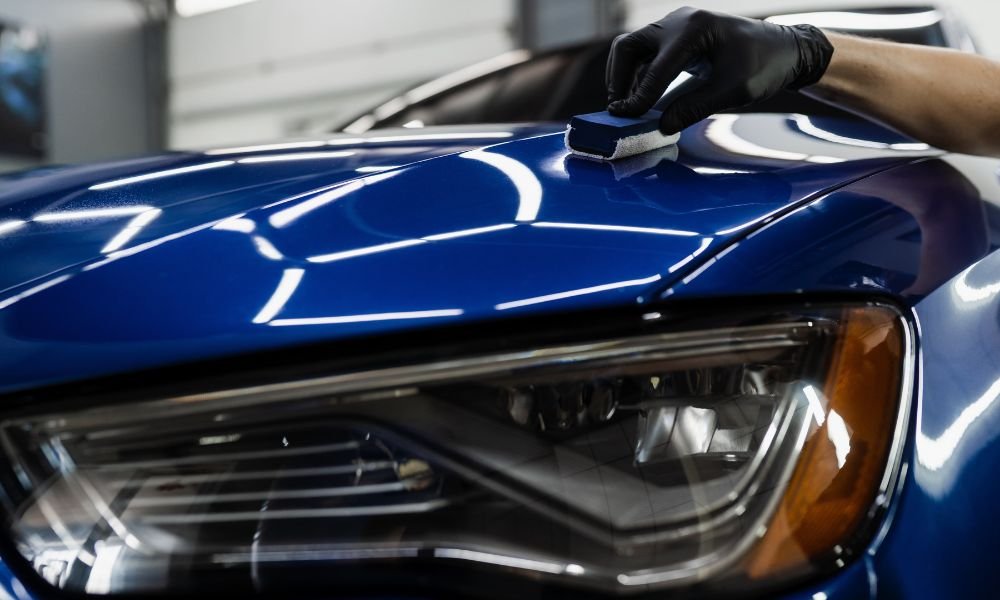Premium Ceramic Coatings San Jose for Ultimate Vehicle Security
Premium Ceramic Coatings San Jose for Ultimate Vehicle Security
Blog Article
Introducing the Science Behind Ceramic Coatings: Just How Does It Job and Why Is It Superior to Typical Options?
Ceramic finishings have been getting appeal in different industries for their remarkable performance and durability. Comprehending how ceramic coatings job and why they outshine traditional choices is critical for those looking for to enhance the long life and durability of their products.
The Chemistry of Ceramic Coatings
In comprehending ceramic coverings, diving into the intricate chemistry behind their make-up is crucial for realizing their performance and resilience. Ceramic layers are mostly composed of silicon dioxide (SiO2), which creates a strong and safety layer when applied to various surfaces. This chemical structure supplies remarkable resistance to warmth, chemicals, and corrosion, making ceramic coatings very sought after for a vast range of applications.
The chemistry behind ceramic layers involves the development of covalent bonds in between silicon and oxygen atoms, creating a stiff network that boosts the covering's durability and toughness. Additionally, the existence of various other elements such as aluminum, titanium, and zirconium additional boosts the coating's buildings, supplying raised firmness and adhesion to surface areas.
Comprehending the chemical structure of ceramic finishings permits for the customization of formulations to fit specific needs, whether it be for vehicle, industrial, or residential functions. By harnessing the power of chemistry, ceramic finishings remain to lead the method for remarkable defense and efficiency in numerous industries.
Benefits of Ceramic Coatings

As an outcome, ceramic coatings make cleaning and preserving surface areas a lot simpler and much less time-consuming. In general, the wide range of advantages offered by ceramic coverings make them a superior choice compared to conventional finish techniques.
How Ceramic Coatings Bond
Ceramic finishes bond to surfaces via a procedure that entails molecular attachment and chemical communications. When a ceramic coating is applied to a surface area, it develops a strong bond by chemically sticking to the surface area at a molecular degree.
Additionally, the chemical communications between the ceramic covering and the surface even more improve the bond. ceramic coatings san jose. These interactions permit the ceramic layer to produce a continual and seamless layer externally, providing superb security and longevity. Unlike typical layers that may rest on the surface check area without completely bonding, ceramic coatings develop an irreversible bond that is resistant to chemicals, UV rays, and severe ecological problems

In essence, the bonding system of ceramic coatings ensures a durable and efficient protective layer that outperforms typical finish options. This premium bond contributes to the longevity, scratch resistance, and long life of ceramic finishings, making them a recommended option for numerous applications.
Sturdiness of Ceramic Coatings
The remarkable long life of ceramic finishings stems from their robust molecular attachment and chemical interactions with surface areas, ensuring a sturdy protective layer that exceeds typical covering choices. As soon as applied, ceramic layers form a solid bond with the substratum, developing a resilient obstacle versus various environmental stress factors such as UV radiation, chemicals, and abrasions. This bond is so protected that it can withstand the rigors of everyday usage without degrading or degrading rapidly.
Unlike conventional finishings that may degrade over time, ceramic layers maintain their honesty for a prolonged period, providing long-lasting protection for the underlying surface area. In general, the extraordinary sturdiness of ceramic coverings makes them a superior selection for safeguarding a vast variety of surface areas in different applications.
Ceramic Coatings Vs. Typical Choices
In comparison to traditional finishing techniques, ceramic coatings use a distinct mix of longevity and safety capacities that set them apart in numerous surface protection applications. Standard options such as wax or sealers provide a momentary layer of defense that can disappear quickly, requiring constant reapplication. On the other hand, ceramic layers create a strong bond with the surface area, developing a irreversible or semi-permanent obstacle that is very immune to abrasion, chemicals, UV rays, and extreme temperature levels.
Furthermore, ceramic finishings use remarkable hydrophobic buildings compared to typical finishings. The hydrophobic nature of ceramic finishes triggers water to bead up and roll off the surface area, carrying dust and impurities with it. This self-cleaning effect helps to keep the surface area's tidiness and gloss for extended durations, lowering the need for constant upkeep.
Furthermore, ceramic coverings have a thicker layer compared to traditional choices, supplying you can look here boosted scrape resistance and security versus minor impacts. This sturdiness guarantees long-lasting efficiency and helps maintain the aesthetic charm of the treated surface area for an extended duration.
Conclusion
In verdict, the scientific research behind ceramic coatings lies in their chemical make-up and bonding residential or commercial properties, making them premium to conventional alternatives. The benefits of ceramic finishes include boosted resilience and security for surface areas. By comprehending just how ceramic coverings job and their benefits over conventional choices, one can make informed choices when taking into consideration layer choices for different applications.
Unlike conventional finishes that might sit on the surface without fully bonding, ceramic coverings produce an irreversible bond that is resistant to chemicals, UV rays, and rough environmental conditions.
The exceptional durability of ceramic layers stems from their robust molecular attachment and chemical communications with surfaces, ensuring a long lasting safety layer useful link that exceeds traditional layer options.Unlike typical coatings that might weaken over time, ceramic coatings maintain their integrity for an extended period, offering resilient defense for the underlying surface area.In contrast to standard layer approaches, ceramic coatings provide a distinctive blend of resilience and protective capabilities that set them apart in numerous surface protection applications. By understanding how ceramic coverings work and their advantages over standard choices, one can make informed decisions when taking into consideration layer alternatives for various applications.
Report this page